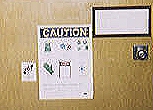Labeling and Marking
Systems
 |
Always read the labels provided on the
products
you use!!! |
These
will provide you with a wealth of information you need to know in order to use the product
safely.
In
addition to the manufacturers' labels which are provided on most chemical products, OSU
uses three labeling and marking systems:
- Hazardous
Materials Labeling System (HMLS) labels
- National
Fire Protection Association (NFPA) diamonds
- Uniform
Laboratory Hazard Signage (ULHS) system
The
first two of these systems rely on color coding and a numerical rating system to identify
the hazard and its severity. The ULHS system identifies the areas where hazardous
substances are used or stored through pictograph symbols.
NFPA Diamonds
OSU
buildings will have NFPA diamonds located inside the main entrance (usually near the fire
alarm panel) or on the outside of the main entrance door. Each diamond represents a
different hazard.
Blue = Health Hazard
Red = Flammability
Yellow = Instability
White = Special Hazard Information
A
numerical rating will also be provided in the blue, red, and yellow diamonds. This number
indicates the severity of the hazard, with a 0 indicating no hazard and 4 indicating the
most severe hazard.
These
placards represent the "worst" of what is in the building, but they will not
provide specific chemical names, quantities, or locations. They are designed to give
emergency personnel a general idea of the worst hazards present in a building or area.
Key to the NFPA Diamond

HMLS Labels
The
HMLS labeling system operates on the same principle as the NFPA diamond. Blue indicates health hazard, red indicates
flammability, yellow indicates instability, and special information (such as what personal protective equipment to wear) will be
provided in the white section. It also uses a numerical system from 0-4 to indicate the
severity of the hazard.
These
labels should be used on individual containers of hazardous materials (ie. barrels,
bottles, cans, buckets, tubs, etc) so that there are never any unlabeled containers in the
work area. It is recommended that they be used on all containers, even if the
manufacturer's label is still in place; however, this is just a recommendation.
Always regard unlabeled containers as dangerous!
If
a substance is transferred from its original container into a portable container which is
not labeled, the portable container must be labeled with an HMLS label to identify the
contents of the container. All unattended containers shall be labeled.
HMLS
labels are available in a variety of sizes from the EHS department.
HMLS Label

Key To HMLS Label Numerical
Ratings
HEALTH
| 4 |
Deadly: even the slightest exposure to this substance would be life threatening.
Only specialized protective clothing, for these materials, should be worn. |
| 3 |
Extreme Danger: serious injury would result from exposure to this substance. Do
not expose any body surface to these materials. Full protective measures should be taken. |
| 2 |
Dangerous: exposure to this substance would be hazardous to health. Protective
measures are indicated. |
| 1 |
Slight Hazard: irritation or minor injury would result from exposure to this
substance. Protective measures are indicated. |
| 0 |
No Hazard: exposure to this substance offers no significant risk to health. |
FLAMMABILITY
4 |
Flash Point Below 73ºF and Boiling Point Below 100ºF: this substance is very
flammable, volatile or explosive depending on its state. Extreme caution should be used in
handling or storing of these materials. |
3 |
Flash Point Below 100ºF: flammable, volatile or explosive under almost all
normal temperature conditions. Exercise great caution in storage or handling of these
materials. |
2 |
Flash Point Below 200ºF: moderately heated conditions may ignite this substance.
Caution procedures should be employed in handling. |
1 |
Flash Point Above 200ºF: this substance must be preheated to ignite. Most
combustible solids would be in this category. |
0 |
Will Not Burn: substances that will not burn. |
INSTABILITY
4 |
May Detonate: substances that are readily capable of detonation or explosion at
normal temperatures and pressures. Evacuate area if exposed to heat or fire. |
3 |
Explosive: substances that are readily capable of detonation or explosion by a
strong initiating source, such as heat, shock or water. Monitor from behind
explosion-resistant barriers. |
2 |
Unstable: violent chemical changes are possible at normal or elevated
temperatures and pressures. Potentially violent or explosive reaction may occur when mixed
with water. Monitor from a safe distance. |
1 |
Normally stable: substances that may become unstable at elevated temperatures and
pressures or when mixed with water. Approach with caution. |
0 |
Stable: substances which will remain stable when exposed to heat, pressure or
water. |
Uniform Laboratory Hazard
Signage
 |
Laboratories should be marked with the appropriate pictographic symbols to warn
employees, visitors, and emergency responders what precautions should be observed when
entering the laboratory, as well as what hazards to expect inside. |
EHS can provide
pictographs for a variety of hazards such as these:
The Four Stages of OSU's Program
 Material Safety Data Sheets
Material Safety Data Sheets
 Labeling and Marking Systems
Labeling and Marking Systems
 Employee Training Sessions
Employee Training Sessions
 Written Right-to-Know Plan
Written Right-to-Know Plan
 Quiz
Quiz
At
Oklahoma State University, the office of Environmental Health and Safety may be contacted
to assist departments with their Hazard Communication and the required training.
Check out OSU EHS's online PPE Information
Library for additional information.

